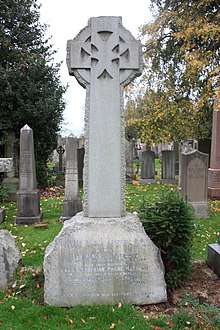James Macphail

James Calder Macphail (21 February 1821 – 12 February 1908) was a Scottish Free Church minister and Gaelic tutor. He is best remembered as a pioneer photographer and one of the very first to photograph the Holy Land.[1]
Life


He was born on 21 February 1821 near Loch Broom in Wester Ross in northern Scotland.
In 1847/8 he travelled to Italy and Malta.[2] Four photographs from this trip still exist.[3] He was a friend to James Dunlop (1830-1858) and his uncle Alexander Earle Monteith. His friend Cosmo Innes encouraged him to take an interest in photography and he joined the Edinburgh Calotype Club in 1843 aged only 22.[4][5]
He studied divinity at the University of Aberdeen, Divinity College and New College, Edinburgh. He was ordained in the Free Church of Scotland in 1849, and his first charge was in Aberdeen.[6][7] In 1868 he moved to the newly completed Pilrig Church on Leith Walk designed by Peddie & Kinnear.[8] He replaced Rev William Garden Blaikie who oversaw the building of the new church, replacing an earlier structure by David Cousin on the opposite side of Pilrig Street.[9] He would have then lived in the associated manse, at the north end of Pilrig Street facing the grounds of Pilrig House (later becoming Pilrig Park).
In 1869 he founded a bursary to Gaelic-speaking boys to fund their university education for the Free Church of Scotland.[10]
In the 1870s he made a photographic tour of the Holy Land.
He remained minister of Pilrig Church until at least 1895, continuing to live at Pilrig manse. By this stage the University of Edinburgh granted him an honorary doctorate (DD).[11] He left Edinburgh on retiral around 1896.
He died on 12 February 1908 and is buried in the first northern extension of Dean Cemetery in western Edinburgh.
Family
He was married to Ann Badenach Nicolson (1834-1918).
They had two daughters, Annie Catherine Phebe Macphail and Sybella Mary Macphail.
His elder son James Robert Nicolson Macphail (1858-1933) was an antiquary,[12] while his younger son Earle Monteith Macphail (1861-1937) was a missionary to India who became principal (1921) and vice-chancellor (1923-5) of Madras University and rose to a senior position in colonial politics, rising to become deputy chairman of the Legislative Assembly of India in 1927.[13]
Publications
- Old Stones for a New Church (1877)
References
- ↑ The Photography of Victorian Scotland, Roddy Simpson
- ↑ Hannavy, John (2013-12-16). Encyclopedia of Nineteenth-Century Photography. Routledge. ISBN 9781135873271.
- ↑ Griffiths, Alan. "Luminous-Lint - Photographer - James Calder Macphail". www.luminous-lint.com. Retrieved 2018-01-18.
- ↑ "Photographs by Macphail". National Library of Scotland.
- ↑ "Edinburgh Calotype Club Album - Volume 2 - Story". www.edinphoto.org.uk. Retrieved 2018-01-18.
- ↑ "Macphail, James Calder (1821-1908)". National Library of Scotland. Retrieved 2018-01-20.
- ↑ "Macphail, James Calder (1821-1908)". National Library of Scotland.
- ↑ Buildings of Scotland: Edinburgh, by Gifford, McWilliam and Walker
- ↑ The Kirk at Pilrig: Stuart W. Sime
- ↑ "Rev Dr James Calder MacPhail and of sheriff J R M MacPhail papers - Tasglann nan Eilean Siar". ica-atom.tasglann.org.uk. Retrieved 2018-01-18.
- ↑ Edinburgh Post Office Directory 1895
- ↑ MacPhail, James Robert Nicolson : Oxford Dictionary of National Biography - oi. doi:10.1093/ref:odnb/53044.
- ↑ "Macphail Papers". Mundus. Retrieved 4 November 2017.